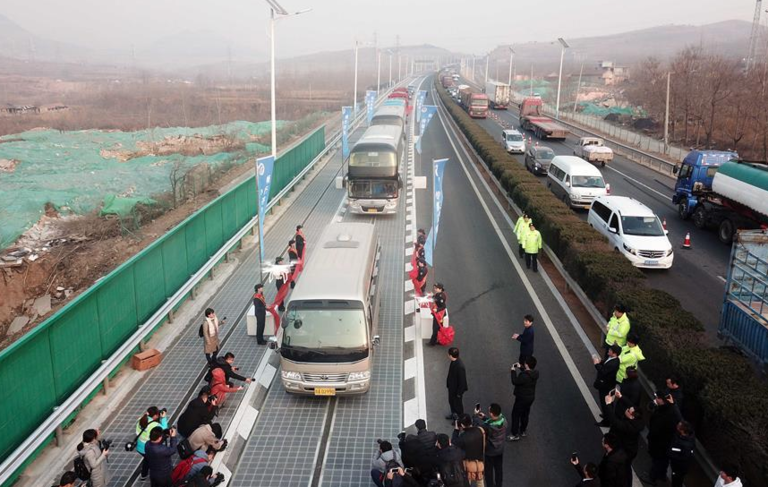
Yesterday, China announced the opening of a 1-kilometer (0.6 mile) solar highway in the city of Jinan, 265 miles south of Beijing.
According to Xinhua, China’s official news agency, the project will serve as a clean energy test bed to evaluate new technologies, with an overarching goal to reduce the amount of land needed for solar farms and transmission wires.
The road surface is made out of panels described as a “transparent, weight-bearing material” that still allows sunlight to pass through. Those panels cover an area comprising almost 1.5 acres. Qilu Transportation Development Group, the contractor leading this project, claims the solar power-generating road can generate 1 million kilowatt hours (kWh) of electricity, enough to meet the power requirements for about 800 households.
For now, the power gained from this project will electrify local highway lights, billboards, surveillance cameras and toll gate entrances. Excess power will be supplied to Jinan’s local grid.
This project’s exact cost was not disclosed by Qilu or local officials, but Xinhua noted that its price tag is about half that of similar projects launched around the world. Quartz has reported that the estimated cost was about $458 per square meter, or a total of $2.7 million.
Similar projects worldwide have succeeded in scoring copious amounts of headlines, as well as questions about whether the benefit of these experiments are really worth their cost. And of course, China has a history of announcing eye-popping infrastructure projects that at first seem a great leap forward for sustainability until they are given a closer once-over. For example, a “straddling bus” last year scored plenty of buzz at first, followed by heaps of ridicule.
Other solar roads built elsewhere have proven to be a mixed bag. A solar bike path in the Netherlands cost an estimated $3.7 million to build. On the plus side, the road near Amsterdam attracted at least 150,000 curious cyclists during its first six months. Indeed, this is an interesting technology for clean technology aficionados, as it could help future engineers develop more resilient and high-performing solar panels. But over that same time span, the road generated only 3,000 kWh – enough to power one home. Those numbers are going to need quite the boost (and costs, including those for maintenance, will have to spiral down) if cities will even come close to the thought of ripping out of asphalt and concrete and replacing them with next-generation solar panels at any point soon.
Last year, the world’s first so-called solar road for cars and trucks opened in France. The same length as the one that launched this week in China, the project in Normandy cost about $6.7 million. This aim of this venture is to gauge whether the panels used on this two-lane road can withstand the weight imposed by thousands of vehicles passing over it day to day. But again, the project raises far more eyebrows than keeping any lights illuminated: the amount of power this project generates is only sufficient to keep the streetlights in the nearby town of 3,300 on at night.
Doubts about this project's efficacy notwithstanding, the Jinan solar road showcases the growth of renewables in China, to the point that the country now is now the world’s largest solar producer. Critics, however, quickly counter that the country by far is still the globe’s largest carbon emitter.
Image credit: Xinhua

Leon Kaye has written for 3p since 2010 and become executive editor in 2018. His previous work includes writing for the Guardian as well as other online and print publications. In addition, he's worked in sales executive roles within technology and financial research companies, as well as for a public relations firm, for which he consulted with one of the globe’s leading sustainability initiatives. Currently living in Central California, he’s traveled to 70-plus countries and has lived and worked in South Korea, the United Arab Emirates and Uruguay.
Leon’s an alum of Fresno State, the University of Maryland, Baltimore County and the University of Southern California's Marshall Business School. He enjoys traveling abroad as well as exploring California’s Central Coast and the Sierra Nevadas.














